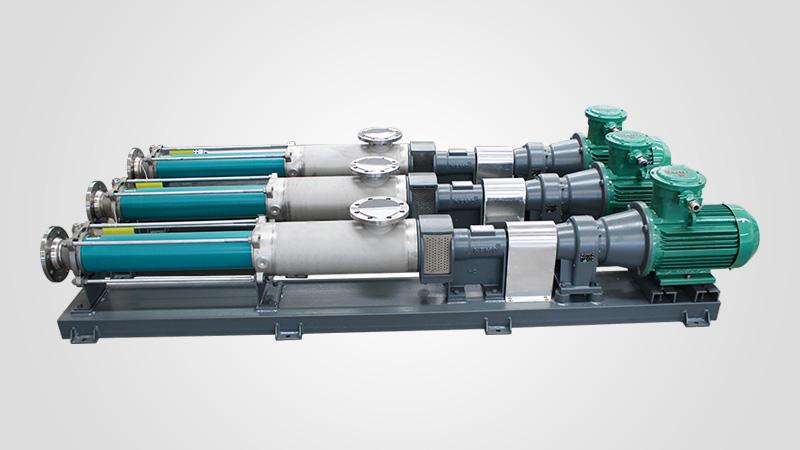What is the special feature of screw pumps? What liquids are they used for? What is the principle of operation? Where is this type of pump used?
Today, we are focusing on screw pumps. The robust construction, modular design and extensive pump configurations increase process flexibility and operational reliability.
Screw pumps are used for pumping viscous liquids. They are efficient and provide high pressure. In this article, we will discuss how they work, what their strengths are, and where this type of pump is used.

Screw pumps are positive displacement pumps. They are a type of rotary gear pump and are divided into single screw and multi screw pumps. A multi-screw pump is a pump in which the main driving screw (rotor) is spirally coupled to one or more screws. When the main screw rotates, the driven screws also start to rotate. Multi-screw pumps have a higher efficiency and the ability to create a higher outlet pressure. In this article, we will look at the principle of operation and design of pumps that are most commonly used in industrial production - single screw pumps.
Single screw pumps can be divided into high-capacity pumps (for pumping large volumes of product) and screw pumps (for barrels, Eurocubes and other mobile containers).
The former have a massive design and are designed to pump a large volume of liquid without submerging any of their parts into the container. The latter, on the contrary, have a submersible part of such a diameter that can be installed in the filler hole of the barrel. However, these pumps have a similar design, are self-priming and are capable of pumping viscous liquids.
Let's take a look at the design and principle of operation of a screw pump. Any screw pump can be divided into two parts. The first part moves the pump's working body, thereby causing the pump to pump liquid. It includes a motor and a gearbox. The second part is the mechanical part of the pump, thanks to which the liquid is pumped with a certain capacity and pressure.

Mechanical part
The main components of the mechanical part of a screw pump are the rotor (1), stator (2), pump inlet/outlet with threaded connection (3), bearing housing (4), mechanical seal (5) and universal joint (6). All of these parts are connected in series with each other and are housed inside special supports (7).
How the pump works
The pump is connected to an electrical circuit or pneumatic line. When the pump is switched on, the motor shaft starts rotating at a certain number of revolutions per minute. The rotation of the motor shaft is transmitted to the gearbox shaft via a coupling. The gear wheels of the gearbox, which are in series meshing, reduce the number of revolutions at the output of the gearbox and increase the torque. The angular velocity of the gear motor is transmitted to the PTO shaft or conveying auger via the adapter shaft in the bearing assembly, which in turn drives the pump rotor via a hinged joint.


Types of installation of screw pumps
As discussed earlier in this article, vertical screw barrel pumps are a type of screw pump that is similar in design and operation to horizontal pumps, but has a rather limited scope of application.
A standard screw pump is installed on a horizontal surface and secured to it with special supports. The barrel pump is mounted vertically in the tank. However, there are non-standard installation options: vertical for a conventional screw pump and horizontal for a barrel screw pump. Replacing the horizontal installation of a screw pump with a vertical arrangement is usually due to the consumer's desire to save production space or in cases where it is simply not possible to install the pump horizontally. This once again confirms the versatility of this type of pump.
Rotor pair geometry

Advantages.
- The pump is a volumetric type and each revolution of the rotor equals a certain volume of the pumped medium, so it is possible to precisely control the capacity.
- The pump is self-priming.
- Because the rotating parts are directly connected to each other and the volumetric cavities between the stator and rotor are sealed, the pump has a high efficiency.
- The pump can be used in both horizontal and vertical positions.
- The pump can pump liquids in different directions as it has a reverse function.
- The pumped products are not subjected to either shock or compression, which does not destroy their structure (the flow regime is close to laminar).
- Different pump designs are available depending on the customer's application.
- The ability to achieve high performance. stable discharge pressure at different rotor speeds.
- The pump can pump liquids saturated with gases, as it is not sensitive to cavitation and hydraulic shocks.
- Quiet operation of the mechanical part.
- Only the pump drive is audible during operation.
- Low power consumption when using an electric motor as a drive.
Application of screw pumps
Screw pumps are widely used in various industries. Due to the specifics of the product being processed, namely high viscosity and density, these pumps are widely used in the food industry. They are used in winemaking (wine, grapes), in the dairy industry (butter, yoghurt, sour cream, ice cream, cream, milk, kefir, cheese, margarine, condensed milk), in confectionery (honey, molasses, chocolate, jam, jelly, mousse, cream), for various sauces and condiments (mustard, ketchup, tomato paste, mayonnaise), etc. They are used in the cosmetics industry (shampoo, liquid soap, hair dyes, lipstick, creams), the oil industry (oil, bitumen and polymeric materials, diesel fuel, fuel oil, petrol), and the chemical industry (detergents, inks, paints, glues, acids, alkalis), the pulp and paper industry (flocculants, sludge, paints, paper pulp, pulp and water, dyes), and in the treatment of domestic and industrial wastewater (flocculants, coagulants, sludge, sludge, sapropel).